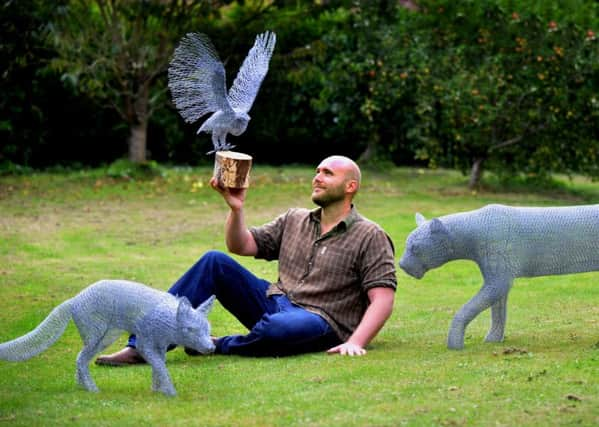East Yorkshire artist's wire animals are in-demand


Richard is a wire sculptor and his animal and bird creations such as his most popular ‘Landing Barn Owl’ with wings outstretched, and a leopard that he has spent a week working on, have already seen him turn an initial interpretation of something he saw by chance last year into a thriving enterprise.
Richard, who has gone on to bag several commissions and displays of his work in local galleries, grew up at Londesborough Wold and lives with his mum and brother James in the village of Shiptonthorpe near Market Weighton.
Advertisement
Hide AdAdvertisement
Hide AdThe countryside has always inspired him and has led to a passion for art and wildlife that has seen him sketching, painting, becoming a taxidermist, study ecology and become employed by Driffield-based Wold Ecology as a surveyor of bats and newts.
Explaining his artistic journey, Richard says: “I used to sketch a lot as a kid and it was always wildlife. I was quite locked-in to sketching birds of prey and I was lucky that the teachers at school noticed me, but the amount of people who tried to put me off art as a career was unbelievable.
“I let things cool off for a bit, went to Bishop Burton College to study ecology, but then I became a lot more interested in 3D art through taxidermy. I’ve had commissions for a number of foxes and pheasants in that genre, and I’m now thoroughly enjoying working with wire.”
It was Richard’s work with Wold Ecology that brought about a shift in his artistic work.
Advertisement
Hide AdAdvertisement
Hide Ad“I was conducting a newt survey and was taken with a wire model of a duck. I decided to try making my own at home and found that I really enjoyed the process. It’s a real art form.
“I prefer an open wire approach rather than using a mannequin, which is the way some other artists do it. I use ordinary fencing wire.
“I tend to start with the body, whereas if I draw I start with the head. I’ve found it’s pointless me crafting a beautiful neck and head with wire because when I get to the body I might not like the angle of the head. I put together an initial rather crude head just to give me proportion. If I feel any sense of frustration coming on, which can happen after a few hours of crafting, I will go for a cup of tea then come back, take a look and everything seems clearer.
“Gloves are one of the tough things in this line. I do wear them but I can’t use gloves that fully protect me because I need the dexterity in my fingers and wearing them means losing that feeling for the piece. So I use machinist’s gloves as a kind of middle ground and get puncture wounds on a daily basis, although nothing too bad.”
Advertisement
Hide AdAdvertisement
Hide AdProduction of the various birds and animals from terriers to kites and leopards can take anything from a day and a half to a week. It’s time consuming but Richard finds it extremely satisfying.
“What I really like with each piece is that I’m going for a freehand outer skin with no internal wire. Each piece then radiates light. If you have them in your garden they will glow, but the biggest kick I get is seeing the big smile on someone’s face when I take them the final product.
“I went full-time with this in March this year and combine it with taxidermy commissions and some bat and newt surveys.
“I had expected my customers to be mainly countryside people but one thing the past six months has taught me is that the interest can come from anywhere. I also know that I’m never wasting my time producing owls. They’re in demand.”
Richard’s works are currently on display at the Wolds Village Gallery and Tearooms in Bainton and No. 18 Gallery in Driffield.